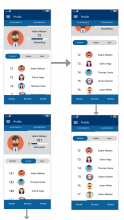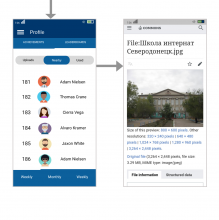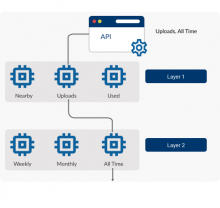Google Summer of Code 2020
Commons-App Android
Implement Leaderboards
Proposal Document
Proposal Summary
#Personal Details
Name: Kshitij Bhardwaj
Github: kbhardwaj123
Email: kshitij256kencryption@gmail.com
Phone No: +91-9634843951
Location: India
Time Zone: India (UTC +5:30)
Slack: Kshitij Bhardwaj
LinkedIn: Kshitj Bhardwaj
Project Overview
At its core the Underlying Goal of This Project is to incorporate the concept of Gamification into the Commons Android Application with the purpose of leveraging User’s interest to increase their Wikimedia edit count. This project aims to realise such kind of Gamification by establishing a Leaderboards for the users wherein they will be ranked based on their edit count via the Commons-App and not the Web portal.The app already implements the level system which can be combined with their ranks (indicative of their edits) and based on that we can award them Rank Badges/Titles whose distribution algorithm has been proposed in detail in this proposal later.
Features
- Implement database schema which is entirely separate from the existing edit counter as it includes counts made from the web portal. The APIs which interact with this particular schema will have their End-points served only to the Commons Android app.
- Leaderboards calculated from the above database schema will serve their results via a single End-point which would accept the following
three parameters:
- Uploads/Nearby/Used ( as single integer viz. 0,1,2 )
- Weekly/Monthly/All (again as integer parameter)
- Username
- Entire Calculations will be accomplished on the server side and the Android app’s leaderboard section will have the sole purpose of displaying the results.
- The Leaderboards will be cached and stored on the server in a database and will be refreshed at regular intervals.
- The leaderboard database includes only those users who have explored the Achievements activity at least once.
- Server will perform complete re-calculation of leaderboard ranks at regular interval of 1 hour, additionally for users who are really intrigued in the leaderboards and check it more than 5 times a day ( on average which will be calculated on a per month basis ) will get updated leaderboard after every 5 minutes interval.
- Implement Rank Badges and/or titles to motivate users to maintain their pace of contributions so as to get a higher badge , apart from that it will prevent users with ranks in orders of thousands to get completely unmotivated as badge distribution will be much more discrete in order of 10 or 20 badges/titles in total. The inspiration for this feature has been from Competitive games like CS:GO, this feature is highly effective in leveraging long term user interest.
- Feature Implementation
- The database schema will provide an end-point to the app which consequently ensures that only the android app users enter the leaderboard database. The Schema can be implemented as mentioned in the model structure diagram sketched in the pdf file.
- The results will be served using a single API End-point as discussed previously, the server side request flow will implement the following pattern: (diagram in pdf file)
- How can this division of requests improve performance ?
The users who are check leaderboards quite often will be marked as Active users, as a matter of fact only a fraction of the total user base will be highly active so even if they are provided with the feature of more frequently updated Leaderboards the server would not have any extra load or request traffic. The Non-Active users would be provided with the leaderboards which are refreshed once in an hour.
- How can Rank Calculation architecture be implemented ?
The API hosting server can run certain services for periodic rank re-calculation, these services can be implemented using the Advanced Python Scheduler ( APScheduler ) or we can also use Python Crontab.
- Uploads Leaderboards:
The commons applications provides public logs of the users which when displayed with conditions type=upload and with tag filter=android app edit we only get the uploads made by the android app as can be seen here .
The API would implement this as follows:
Use commonswiki_p; Select count(*) as edits From logging Join change_tag on log_id = ct_log_id and ct_tag_id=22 Where log_type='upload' and log_actor = ACTOR_ID;
- Nearby Leaderboards:
These are counted when images are uploaded while in
Nearby section so they are automatically from the mobile
app.
- Images Used in articles Leaderboards:
These are calculated from the globalimageslinked table under the GlobalUsage extension, to sum it up:
Use commonswiki_p; Select count(distinct gil_to) from globalimageslinked Where gil_to in (Select log_title from logging Where log_type='upload' log_actor=ACTOR_ID);
- How can Badge Distribution be implemented:
For badge distribution we combine user’s rank ( monthly/weekly rank, could be based on uploads ) with their achievements so as to incorporate long term (the level) and shortterm (weekly/monthly rank) so we define a quantity x whose formula has been described below and we find its standard deviation and the badges are distributed as per the Badge distribution diagram(diagram in pdf) .
UIX (designs)
The Design Screens shown above demonstrate the flow of the app in the leaderboards section, the last screen shows the user screen when the user has clicked on one of the leaderboard position holders, this first opens the commons gallery page of that particular user from where users can open any of the uploaded images (this is exactly what has been shown in the last screen, one of the gallery pictures )
Crud Operations
An Overview of how the crud operations will work has been drawn below
For Evaluating uploads of Single user:
The Leaderboards will be processed in two layers as shown above:
- Layer 1:
The uploads will be derived from joined logging and change_tag tables now we will also have the timestamp in the combined result records, in all the cases (Nearby/Uploads/Used). These results are calculated on the basis of the logic discussed under the heading Rank Calculation.
- Layer 2:
In all the three cases (Nearby/Uploads/Used) the final record list will have timestamp (log_timestamp) now this timestamp will be used to filter the leaderboard results as follows:
- Weekly:
If Current TimeStamp - Log TimeStamp < WeekDuration
Where WeekDuration is the difference between two
timestamps with one week gap.
- Monthly: :
If Current TimeStamp - Log TimeStamp <MonthDuration
- All Time: No additional calculation required.
- Layer 3: Sort the results as per the upload numbers and then store the rank into the particular case (for instance uploads/all) into the field rank_uploads_all in the record of the corresponding user, inside the table edits_commons_app.
The first two Layers will be repeated for every user and for all the (3*3) 9 cases we will store the corresponding fields of the edits_commons_app table.
After the completion of all the three layers we will have a complete leaderboard record of a particular user, this will be repeated for every user. The Rank Badge calculation kicks in at this point, from the algorithm it might seem like the process would be highly taxing for the server but actually it's quite straight-forward. The 9 final ranks per record in the edits_commons_app table leveraged into the standard deviation formula mentioned in the Badge Calculation section.
Project Timeline
Community Bonding, 4th May - 1st June
● Get to know the Community more, and bond with mentors, admins and developers.
● Get feedback if something in the project needs amendment.
● Finalize the Database Schema and APIs.
● Read more about RxJava, APScheduler and other relevant android technologies and concepts.
● Get familiar with Commons database schema and ideate on how it will implement the new tables proposed in the project
● Finalise a barebones implementation of the ui using viewpage and recyclerView in the Achievements activity
● Deliverables:
○ Report on Community
Bonding period
- Phase - 1**
- Week 1** Start UI implementation of primary filters (nearby/used/uploads)with mock data
● Implement basic view pager
● Get approval on database schema changes and gather necessary knowledge on how to implement it.
Week 2
Implement Capsule navigation bar (primary filters)in leaderboards view page.
● Get approval on MySql and MariaDb script code changes
(script 1 and script 2)
● Create Pull Request for script changes, iterate upon received reviews
- Week 3**
Commence coding the python API algorithms for Layer 1 filters(nearby/used/uploads)and storing rank in the database.
● Discuss API code structures with mentors.
● Create Pull Request on commonsmisc repo with the Layer 1 implementation, iterate upon received reviews.
Week 4
● Start Code implementation of APScheduler services (responsible for periodic updation of leaderboards).
● Discuss Services code related issues with the mentors.
● Create Pull Request for services on commonsmisc and iterate upon received reviews.
Week 5
Debug the database and Layer 1 API changes, ensure that they are working in synchronization.
● Ensure only those who visit achievements enter the database.
● Commence recycler view implementation of leaderboards
● Get Approval on the final Leaderboards design along with code logic(upto this juncture).
Week 6
Implement RxJava Observable pattern for the received user list.
● Discuss the final Observable pattern code implementation of leaderboards.
● Create a Pull Request for the work done on a different(from master) branch, amend as per the inputs received.
Week 7
Debug the database-API(Layer
1)-Userlist chain.
● Start implementation of Layer 2 for
API to implement time filters.
Week 8
Complete Layer 2 implementation along with the Rank Badge/Title calculation.
● Synchronise services with the updated APIs(Layer 1 + 2).
● Create Pull Request(not master), iterate on inputs.
Phase 3
Week 9
Commence functional implementation of the time filters in the App.
● Debug combined implementation of all filter combinations in the application
Week 10
Finalise code structure the commence implementation of pagination to facilitate lazy loading.
● Iterate upon the reviews received on the code changes so far and get it merged with master.
Week 11
Finalise how avatars would be stored(possibly local storage or cache).
● Implement avatar display along with Rank Badge display in the UI.
Week 12
Fix the bugs.
● Document as necessary and write unit tests.
● Implement the Avatar change feature.(if time permits)
Additional Dileverables
Write blog posts on medium every alternate week.
● Write weekly report of accomplished tasks on the mailing list (or
something more relevant)
● Prepare and submit a presentation for this project.
Motivation
Google Summer of Code is an excellent platform to get acquainted with the open source community and their skillful mentors. It gives one a professional work experience in their college years where they collaboratively build a product for the welfare of the society. In this process, both the individual and the community progress and flourish. Contributing to Commons has been an enriching experience, the mentors and the community have been really friendly and helpful in giving me constructive criticism making me learn new stuff and improving my coding skills.
Contributions
3422 - For v2.13, handle zoom in media detail view (merged)
❖ 3344 - TextUtils.isEmpty creates problems when unit testing
with Mockito (merged)
❖ 3378 - Ultimate achievement: Too many contributions
(merged)
❖ 3407 - Do not display pins at all when "Needs Photo" is
selected (merged)
❖ 3351 - Pending GCI task: Add java docs to methods which
have it missing (merged)
❖ 3326 - Make category search non case-sensitive (merged)
❖ 3366 - Adds a Test for Method A categories search (merged)
❖ 3332 - add javadocs to the file CategoryItem (merged)
❖ 3512 - Fix App Crashes on opening Contributions from
MainActivity (merged)
❖ 3505 - Media Detail design Overhaul (open)
❖ 3481 - Implement Progress Bar for Zoom Activity (open)
❖ 3513 - Image height remains zero for some time on bad
network (open)
❖ 3343 - TextUtils.isEmpty creates problems when unit testing
with Mockito (closed)
❖ 3436 - Switch to Material Card design for the Media Detail
Fragment (open)
❖ 3506 - Image View Height remains zero for some time on a
bad network (open)
❖ 3507 - App Crashes in MediaDetailsFragment with
ClassCastException (closed by PR 3512)
❖ 3414 - Handle zoom in media details view (closed by PR
3422 )
❖ 3355 - Do not display pins at all when "Needs Photo" is
selected? (closed by PR 3407)
❖ 3295 - Ultimate achievement: Too many contributions
(making our script time out) (closed by PR 3378)
❖ 3278 - Add java docs to methods which have it missing
(closed by PR 3351)
About Me
Full Stack web and native app Developer, currently Hub-Coordinator at Information Management Group (IMG), IIT Roorkee. During my first year at college my workspace was confined to web development, during which I worked on a few applications, for instance IMGSched (application for scheduling meetings and sync to your google calendar), in my second year my workspace expanded to Native app development and some major projects listed in the following section.
My Projects:
● CMS :-
CMS is abbreviation for Content Management System which is manages more than 6000 static pages of the official website of IIT Roorkee, the use of a Content Management system is to make a template for certain type of page (say news announcement page) so that anyone without coding knowledge (say some staff member or professor) can make changes to all those pages of that particular type by just changing the base template and publish changes.
❖ Feature additions to the Institute CMS ( 10 commits )
❖ Role: Backend developer
❖ CMS handles the official website of IIT-R website
❖ It manages more than 6000 static pages on the website
❖ Tech Stack includes Yii 2.0, PostgreSQL, RabbitMq, Apache2
● Placement Flutter :
At the Institute level it is imperative that the information flow is smooth and fast, the official placement app aims to provide the information regarding the placement and internship programs. Additionally the app facilitates direct submission of their resume directly to the companies, the app was migrated from native android
to flutter due to fast development times
❖ The official Placement app of IIT Roorkee
❖ Role: Full stack developer (81 commits)
❖ Currently under development (pre-alpha)
❖ For Security reasons it implements AES-256 encrypted tokens
for auth and resume handling
❖ Shows results for placement and internship seasons
❖ Facilitates submission of Resumes to companies
❖ Github Repo link: Placement-flutter
● Flutter Login Template:
An Open Source boilerplate application which is completely packed with essentials for flutter development such as Stream Providers Implicit Routing and flutter hooks.
❖ Open Source Login Template
❖ Role: Repository creator and maintainer (22 commits)
❖ Includes Form validation
❖ Complete implementation of Routing and Data Streams
❖ Github Repo link: login-boilerplate


